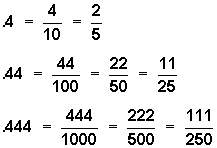Year 2 Lesson Plan 3: Fraction and Decimal
Conversion
- (5 min) Mental Math
- Take 7.2 and multiply by 100 [720]
- What is 25% of 20? [5]
- What is 10% of 40? [4]
- Take the number of days in a week, divide by 2, and multiply by 10
[35]
- Take the number of inches in 1 foot and multiply by 2 [24]
- (5 min) Review of homework #2 (approx 3 problems)
- Pass out the fraction/decimal and percent handout and use it in the following discussion:
- TO CONVERT A FRACTION TO A DECIMAL:
Divide the numerator (number on top) by the denominator (number on
bottom). Use your calculator. First put the numerator into your
calculator, push the divide key, and
then put in the denominator.

- TO CONVERT A DECIMAL TO A FRACTION:
Put the number in the numerator (without the decimal point) and in the
denominator put in a 10, 100, 1000, etc. with enough zeroes so that
the number in the denominator has one more digit than the number in
the numerator. After, that, you should reduce the fraction to its
simplest form. If you have a scientific calculator that does decimal
to fraction conversion, do not use it for this project.

- TO COMPARE FRACTIONS AND DECIMALS:
Convert the fractions to decimals, as we showed you above, and
then compare to see which is larger or which is smaller.
- SPECIAL NOTE:
When serious mathematicians deal with fractions, they write the
divide sign as a horizontal bar. Now it is time to STOP using the
divide sign with two dots, and also STOP using the slash (/) to write
fractions. This is important because next week we will be practicing
cancelling.
- Hand out In-class exercise. If students finish the In-class Exercise
early, check their work and then you can hand out homework.
|